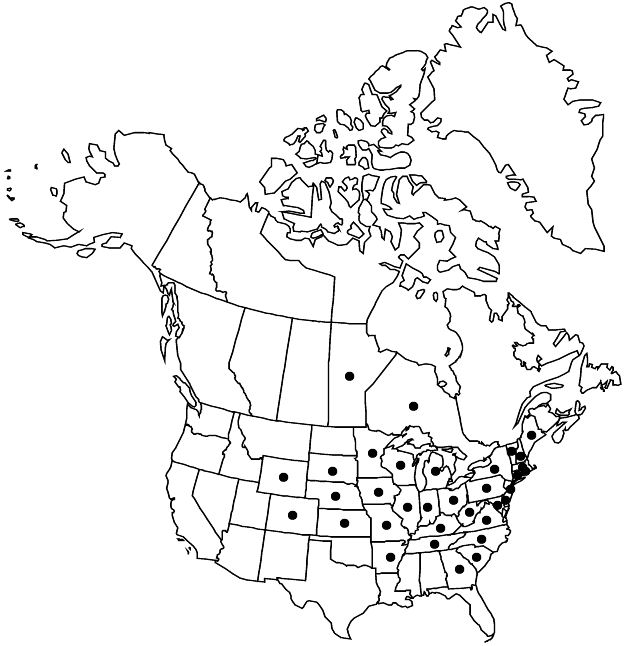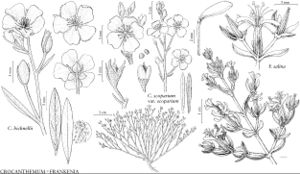Difference between revisions of "Crocanthemum bicknellii"
in H. G. A. Engler et al., Nat. Pflanzenfam. ed. 2, 21: 307. 1925.
FNA>Volume Importer |
FNA>Volume Importer |
(No difference)
| |
Revision as of 20:17, 24 September 2019
Herbs. Stems erect, clustered on vertical caudex, (12–)20–50(–67) cm, simple or branched, stellate-pubescent to stellate-tomentose. Leaves cauline; petiole 1–4 mm; blade narrowly elliptic to oblanceolate, (10–)18–32(–40) × 4–7(–10) mm, surfaces stellate-tomentose abaxially, stellate-pubescent adaxially, without simple hairs, lateral veins raised abaxially. Inflorescences terminal, cymes; chasmogamous flowers 6–10(–18) per cyme; cleistogamous in glomerules, 1–10 flowers per glomerule, on lateral leafy branches 2.5–6 cm, flowering 1–3 months later than chasmogamous. Pedicels (1.5–)3–8(–12) mm; bracts 3–7 × 0.5–1 mm. Chasmogamous flowers: outer sepals linear, 3.5–4.5(–8) × 0.4–1 mm, inner sepals ovate-elliptic, 5–8 × 2.4–4 mm, apex acute; petals obovate, 8–12 × 5–10 mm; capsules 3–5.5 × 2.5–4.5 mm, glabrous. Cleistogamous flowers: outer sepals linear, 0.5–1.5 × 0.3 mm, inner sepals ovate-elliptic, 1.7–2.8 × 1.5–2.3 mm, apex acute capsules 1.5–2.2 × 1.2–2.2 mm, glabrous.
Phenology: Flowering Jun–Jul.
Habitat: Sandy or rocky barrens, glades, sandhills, prairies, fields, pine-oak woodlands, oak-hickory woodlands, montane outcrops and balds
Elevation: 0–1500 m
Distribution

Man., Ont., Ark., Colo., Conn., Del., Ga., Ill., Ind., Iowa, Kans., Ky., Maine, Md., Mass., Mich., Minn., Mo., Nebr., N.H., N.J., N.Y., N.C., Ohio, Pa., R.I., S.C., S.Dak., Tenn., Vt., Va., W.Va., Wis., Wyo.
Discussion
The dense, often crowded, cleistogamous flowers on branches of Crocanthemum bicknellii late in the season
contrast strongly with the relatively few, terminal, petaliferous flowers early in the season. Its closest relative is 12. C. propinquum; see that treatment for identification aids. The names C. majus (Linnaeus) Britton and Helianthemum majus (Linnaeus) Bicknell have been misapplied to C. bicknellii. They were based on Lechea major Linnaeus, which is a synonym of C. canadense, based on types.
Selected References
None.
